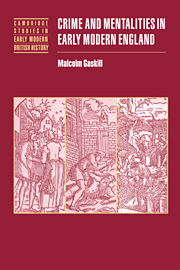6 - Crimes of blood and their representation
from Part III - Murder
Published online by Cambridge University Press: 05 July 2012
Summary
The Lord give all men grace by their example to shunne the hatefull sinne of murder, for be it kept never so close, and done never so secret, yet at length the Lord will bring it out; for bloud is an inceassant crier in the eares of the Lord, and he will not leave so vilde [sic] a thing unpunished.
[Kyd?], The trueth of the most wicked and secret murthering of John Brewen, p. 9The sentiment expressed in this pamphlet reflects a belief universal in early modern England that God exposed and punished the crime of murder, sometimes by direct intervention but more commonly working through temporal agents. This belief, and its public dissemination, served two purposes: it promoted the inevitability of criminal justice, even though most murders were performed secretly and were therefore difficult to detect and prove; conversely, true stories about the undoing of murderers provided graphic exempla of the supreme power of divine providence. Taking this paradigm as their lead, chapters 6 and 7 will address two connected themes: the official and unofficial procedures in which ordinary folk became involved when confronted with crimes of blood; and the thinking which underpinned those procedures and influenced their representation. Change in both areas, especially in the dynamic relationship between community and state concepts of order, tells us much about the development of popular mentalities. Close and careful analysis reveals signs of a gradual transition between regulatory systems: first, a dual reliance upon providence to discover murder and the voice of the people to prove it; thereafter, a greater certainty of detection offered by advances in policing, evidence gathering and medico-legal standards of proof. Although this shift was never absolute - beyond 1750 and even today - by the later seventeenth century, as with the war against the coiners, the enduring structures of Tudor law enforcement were undergoing transformation in order to meet the changing needs of the English state and its people.
- Type
- Chapter
- Information
- Crime and Mentalities in Early Modern England , pp. 203 - 241Publisher: Cambridge University PressPrint publication year: 2000



